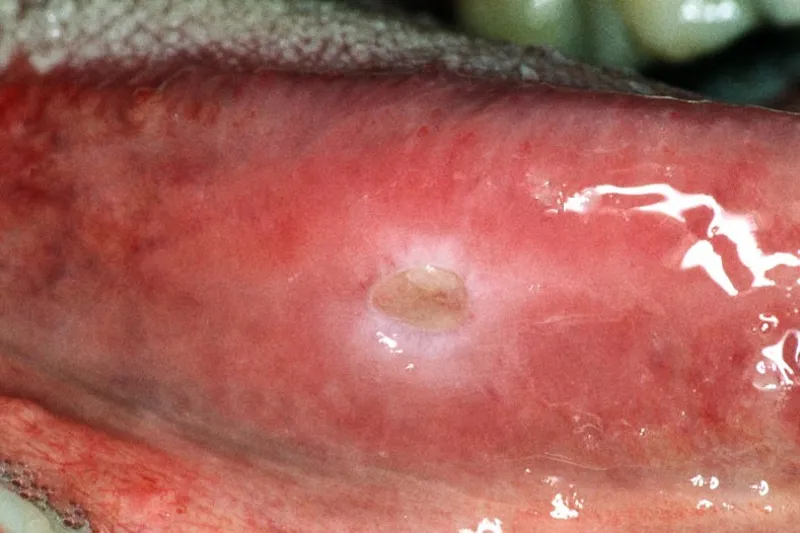Sår i mundslimhinden
I denne artikel gennemgås de mest almindelige sygdomstilstande, der er forbundet med ulcerationer, og differentialdiagnostiske overvejelser i relation hertil.

Sår er hyppigt forekommende i mundslimhinden, og de traumatiske sår udgør hovedparten. Betegnelsen vulnus anvendes om sår udløst af eksogene faktorer, fx traumer fra bid, skarpe fødeemner, forbrænding eller fra tandlægeinstrument. Et vulnus er karakteriseret ved at være akut opstået, ofte smertefuldt og solitært, og det heler spontant inden for 7-10 dage. Et ulcus derimod, der kan hele langsommere, opstår som følge af endogene faktorer, dvs. lokale eller systemiske sygdomstilstande. De hyppigste årsager til ulcera i mundslimhinden er infektion (især virusinfektioner), immunmedieret sygdom (fx lichen planus og inflammatorisk tarmsygdom), immunrelaterede reaktioner (fx medikamentelt udløste reaktioner), autoimmune sygdomme (fx pemfigoid eller lupus erythematosus) eller malign neoplasi. Det er indlysende, at en udførlig anamnese og en grundig klinisk undersøgelse er afgørende for identifikation af eventuel udløsende årsag til et eller flere sår i mundslimhinden og for stillingtagen til videre udredning, herunder biopsi og supplerende parakliniske tests, såfremt årsagen er uklar, og der er systemiske manifestationer. Maligne neoplasier med ulceration kan undertiden være vanskelige at adskille fra tilstande med benigne ulcerationer. En patient med et ulcus, der ikke viser tegn på heling inden for 2-3 uger, skal derfor altid henvises akut for malignitetssuspicio. Desuden bør svære tilfælde af recidiverende aftøs stomatitis og sen debut lede til differentialdiagnostiske overvejelser og henvisning til udredning for underliggende systemisk immunrelateret sygdom. I denne artikel gennemgås de mest almindelige sygdomstilstande, der er forbundet med ulcerationer, og differentialdiagnostiske overvejelser i relation hertil.
Klinisk relevans:
Sår i mundslimhinden er hyppigt forekommende. Hovedparten er traumatisk udløste sår, hvor årsagen er oplagt og ofte kan elimineres, hvorefter såret heler hurtigt og spontant. Sår, der ikke heler normalt og tilbagevendende sår, udgør ofte diagnostiske udfordringer, og alvorlige lokale eller systemiske sygdomstilstande kan ligge til grund. Som tandlæge er det vigtigt at have kendskab til sygdomstilstande, hvor ulcerationer kan være en central manifestation, og vide, hvornår der er grundlag for henvisning, videre udredning og behandling.
Wounds in the oral mucosa
Wounds fare requent in the oral mucosa, and traumatic ulcers comprise the majority. The term vulnus is used for wounds triggered by exogenous factors, e.g. trauma from biting, sharp food substances or a sharp, fractured tooth. This type of wound is characterized by acute onset and typically heals within 7 to 10 days. An ulcer, on the other hand, may heal more slowly, and this type of wound occurs due to endogenous factors, i.e. local or systemic diseases. The most frequent causes of oral mucosal ulcers are infection (especially viral infections), immune-mediated disease (e.g. lichen planus and inflammatory bowel disease), immune-related reactions (e.g. medication-induced reactions), autoimmune diseases (e.g. pemphigoid or lupus erythematosus) or malignant neoplasia. It is obvious that a detailed patient history and a thorough clinical examination are crucial for the identification of a possible triggering cause for one or more ulcers in the oral mucosa, and for deciding on further investigation, including biopsy and supplementary paraclinical tests, if the cause is unclear, and especially with accompanying systemic symptoms. Malignant neoplasms with ulceration can sometimes be difficult to distinguish from conditions with benign ulcerations. A patient with an ulcer that does not show clear signs of healing within 2-3 weeks must therefore always be referred urgently for suspicion of malignancy. In addition, severe cases of recurrent aphthous stomatitis should lead to differential diagnostic considerations and referral for investigation for underlying systemic immune-related disease. This article reviews the most common diseases associated with ulcerations and differential diagnostic considerations in related to those conditions.


